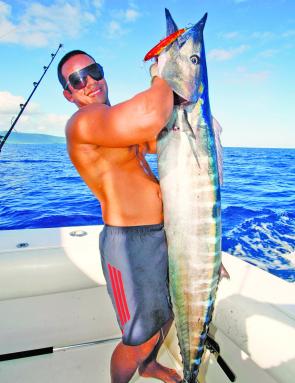For anglers trolling offshore waters wahoo are generally a welcome catch. Apart from destroying the occasional skirted billfish lure, most anglers are rapt at hooking a speedster such as this.
Their aggressive strikes, blistering runs and eating qualities guarantee an angler’s positive view on this species. They are caught on a broad array of lures that are for the most part trolled and can be extremely plentiful in our waters throughout the warmer months. Let’s look at a few ways of getting connected with some blue lightning.
Wahoo are highly predatory fish, regularly travelling and hunting along the ocean currents for prey. Their body is elongated and missile like with scarcely visible scales. Coloration can vary, however they commonly have iridescent blue backs, silvery sides and irregular vivid blue or white baring along their length. The current International Game Fish Association all tackle record stands at 83.46kg for a mammoth wahoo taken at Cabo San Lucas in 2005 by a lady angler.
Fish in our waters along the Southern Queensland coastline are commonly between 6-20kg with the occasional larger specimen to over 30kg encountered each year. Around 10kg seems to be an average school sized wahoo from my experience. Smaller wahoo are generally found in larger packs of 20-50 individuals but as they grow they tend to be found in smaller packs, with the larger fish often being loners.
Wahoo are common throughout tropical and subtropical regions worldwide. Along Australia’s east coast, they are found from Cape York south to Eden, NSW. Their scientific name Acanthocybium solandri literally means thorn and tuna-like, referring to their razor sharp dentures and similarities to members of the tuna and mackerel families. They prefer water temperatures between 20-30c. Commonly they frequent temperature breaks, current margins over seamounts and around coral reefs and flotsam. At times they are found in open water feeding close to the surface in depths that won’t register, even on the best modern day electronics.
FADS (fish aggregating devices) often attract bait species such as juvenile mahi mahi, small mackerels, tunas and other species, which in turn attract the wahoo. In addition to these species they also regularly eat squid, flying fish, porcupine fish, pilchards, gurnards, triggerfish and many other species. Naturally, trolled rigged baits will tempt wahoo, however due to the slow trolling speeds required for this pursuit most anglers opt for lures in their bid to cover as much water as possible in their search.
It is regularly written that wahoo love high-speed lures. As they can swim at speeds in excess of 80km/h nothing can be trolled too fast for these marine missiles. Nonetheless, they will also take a wide array of lures trolled at speeds less than 10knots. The main offerings for wahoo are skirted lures, bibless vibration lures and bibbed minnows. Generally you need to select a high speed or low speed trolling pattern as these lure types all have different ideal speeds and will not always troll well together. If you know there are wahoo in the general area you are trolling, then a low-speed trolling pattern can be employed. If you are searching for fish, especially in more open water then a high-speed pattern will allow you to cover a lot more area and increase the possibility of encountering a wahoo or other pelagic.
Colours for trolling lures can vary and at times one colour may out shine all others on a particular day. Generally it pays to mix up your lure colours a bit until you find some sort of pattern to your strikes. Generally I run darker colours closer to the boat and brighter colours further back, especially in the open clean water. Wahoo definitely have a preference for juvenile mahi mahi so I always include a luminescent or bright green colour in my long lures. Close to the boat, the darker colours like blue, black, purple, gold and dark red will silhouette well against the backdrop of the whitewater created by your prop wash. Good bright colours for your long lures can include yellow, pink, white, luminescent, lime, bright green and light blue. However, there are many varied combinations of any of these colours available so it’s all about finding what works that day. Like all things in fishing, there are often no rules. However on occasions when there are rules, then they are meant to be broken, or so it seems.
One technique that can be employed when trolling with sinking lures like weighted head skirts, blades and bibless minnows is to stall the boat over showings of deeper fish and allow the lures to sink. Once the lures are almost straight down, hit the throttle and motor away at speed. This will often produce strikes while the lures are down deep or will tease fish to the surface where they will often strike on the next pass over that area. Adding a mirrored teaser to your trolling pattern when using slower troll speeds will generally increase your results.
Sometimes when wahoo are found in an area in concentration then they can often be caught with cast and retrieve techniques with jigs, poppers, stickbaits, blades and vibration baits.
Lets look a little closer at some of the types of lures that wahoo will regularly hit on the troll.
Wahoo are like many young men- they will chase anything with a skirt if it takes their fancy at the time. Sometimes wahoo are taken accidently by anglers trolling resin-head skirts for billfish, tuna, dolphinfish and the like. They can make a serious mess of a skirted lure so few will purposely troll their expensive billfish lures to target this species.
One soft, skirted lure that is handy for targeting wahoo at slower troll speeds is the Z-Man Sof-Teaz 9” Bubbler. This lure is entirely made from Elaztech, a material that is extremely difficult for any toothy critter to tear or bite through.
Most resin-head skirts have troll speeds less than 9knots so they aren’t the best option when you are trying to cover a good degree of water. Some manufacturers add a little weight to their resin head skirts so you can increase the maximum trolling speeds a little. Black Bart has been spurred on by the competitive and lucrative wahoo tournaments in the USA, adding a lot of weight to some models of their resin head lures to make them hold into the water at high speeds. Their Rum Bay Candy, San Sal Candy, Crooked Island Candy and Wahoo Candy are top shelf skirted lures designed specifically for high-speed wahoo trolling. Standard fare for many anglers are weighted-head skirted lures such as Hex Heads, Hex Jets, Fireheads, TT Jetheads and Dennis Braid Lures, which have been especially manufactured with high-speed pelagic trolling in mind. Naturally they are perfect for tempting wahoo.
Most weighted-head skirts have a cup-shaped face but some have more of a bullet shaped head. Those with some cupping in the face of the lure will additionally run reasonably well at slower troll speeds but come into their own with long smoke trails and rapid yet tight vibration when trolled at speeds in excess of 9knots. They also hold into the water well in rougher conditions.
Weights need to match the line class to a degree. With most anglers trolling line classes between 8-24kg for wahoo along our coastline, lure weights between 150-300gm are commonly used. These weighted skirts will travel just below the water surface, grabbing air as they periodically surface. This creates a smoke trail along and behind the lure that increases its visibility to predatory species. Weighted head skirts are ideal for wahoo most of the time however they regularly suffer skirt damage due to the wahoo’s razor like teeth and the slashing nature of their strikes.
Lures with lips or bibs are designed for diving deeper under the surface. The resistance of the water on the bib will pull the lure down and also help to provide the lure with its action. Most are floating lures with diving depths between 1-8m. Generally the deeper the diver, the slower the troll speeds will need to be. However most bibbed minnows will run well at speeds between 4-9knots. These lures are ideal when the wahoo are hanging a little deeper over structure or in areas of upwellings and turbulent water. They are ideal for covering smaller areas of water, especially when you know wahoo are in the area.
Bibbed minnows can be run in combination with resin-head skirts or when using weighted-head skirts at slower troll speeds. We sometimes run one or two while trolling resin-head skirts in hope a wahoo will eat them and not our expensive billfish lures.
Some of the more popular diving lures include Rapala X-Rap Mag, Classic Bluewater, Berkley 3B Monster, Halco Laser Pro 190, Sebile Koolie Minnows, Yozuri Hydro Magnums and Rapala CD Magnums.
Sometimes after we have trolled at higher speeds to find the fish we will then switch over to the diving lures because they often produce more strikes. However this is dependant on the fish’s mood on the day. The hook-up to strike rate with bibbed minnows is usually high. You tend to get a higher degree of missed strikes or torn hooks when trolling weighted head skirts. However, speed is often the catalyst for the initial strike so it pays to mix it up a bit some days.
Bibbed lures are generally rigged with treble hooks when they are purchased however many anglers will often convert to doubles or single hooks. These often set a little better and are less likely to come out during a fight as they offer greater purchase on the fish’s mouth. Quality, heavy-duty doubles are not that easy to come by however Mustad and Gamakatsu both have some larger sizes available.
Singles offer good hook sets and are also less dangerous to the angler while securing, handling and unhooking the fish. A swivel is often used to join the hook to the lure, which decreases the torque at this point. Good single hooks are available from Owner, Shogun, Mustad, Black Magic and Gamakatsu just to name a few. The Owner Jobu is the best hook for the job in my books but is a little more expensive than many of the others.
An economical option is to store all your large bluewater minnows without hooks and just put hooks on when you are going to use the lure. This can be done in a few seconds with a good set of split ring pliers such as the Black Magic pliers or Owner GP-60. When changing the lures in your spread, just swap the hooks over from one to the other. You will still need several sets of hooks in different sizes, however this will make it easier to store your lures and will also decrease the likelihood of rarely used lures having rusted or blunt hooks on them when you do want to use them. You can also afford to use quality hooks instead of cheaper ones and will only need to buy more hooks if you lose a lure.
When utilising Owner Jobus or any other chemically sharpened hooks for trolling applications, ensure you add a little anode tape to the hooks to prevent the effects of electrolysis, which can make the points brittle and speed up the rusting process. There are several adhesive anode tapes available including the Owner Rustop. If memory serves me correctly, Shogun and Jinkai also have similar products.
There are heaps of vibration lures available with both bibless minnows and blades being ideal for wahoo when used in the larger sizes. Bibless minnows are roughly fish shaped and relatively thin in profile. They can generally be trolled at speeds between 6-15knots and have a very tight shimmy in the water. Many also have the audible attraction of bearings or rattles inside the lure to add appeal and an aggravator for predator fish.
Bibless minnows, or vibration baits, are ideal for trolling in rough conditions, providing a lot less pressure on the rod tip than bibbed minnows. I believe these are the most under-rated lure for offshore trolling as they are simple to use and will take most species. Bibless minnows are tough, relatively inexpensive and provide less teething problems than many other types of lures for anglers new to bluewater trolling. Due to their variable trolling speeds they are ideal for use in any conditions from calm seas to rougher conditions when the boat is stalling and surging between the wave troughs.
Some of the more readily available bibless minnows include River2Sea Killer Vib and Terminator Vib, Halco Trembler and Max 130, Reflecta B18 and B23, Lively Lures Mack Bait and Dennis Braid’s Black Jack, Speedster and Marauder.
One exception to this range of bibless minnows is the Sebile Bonga Jerk Salt&Sun. These lures travel less than a metre below the surface at speeds to 22knots when flatlined. They have a frantic, meandering and darting action in the water and are ideal for running short or long. Bonga Jerk S&S are wire reinforced, come fitted with extra strong hooks and are fully foam filled. Therefore, even if a tooth penetrated their hard exterior they will not become water logged. Bongas will still run well at low speeds but are without a doubt the most remarkable high-speed lure I have ever used. These are ideal for trolling when you are travelling from one location to the next as they will troll at faster speeds than any other lure. Often, larger wahoo are loners found out in open water and with a few Bonga Jerk S&S on your lines when moving to your next destination, you are likely to stumble across some XXL wahoo on your travels.
Another form of vibration lure are blades. These have become popular for everything from bream to snapper in the smaller sizes but they are also highly productive in the larger sizes for wahoo and other bluewater pelagics. They are basically a solid steel fish profile with keel weighting on the bottom that helps them to hold in the water and gives them their vibration. They often have two to four towing eyelets. For slower speeds use the eyelets closer to the back and for fast speeds use the ones closest to the head. These blades are naturally very tough and will generally reach speeds to around 15knots. In addition they can be vertically jigged if the need arises. Some of the more readily available models include the Spanyid Super Blade, Braid Runner and the River2Sea Steel Tremor.
Wahoo naturally have extremely sharp teeth therefore wire is a good insurance against getting bitten off. If a wahoo swallows the entire lure then a monofilament or fluorocarbon leader will severe the moment it comes into contact with the teeth, no matter how thick or heavy it is. Wire of some variety is obviously the safest leader material to use and in addition it can also help your lures to swim true. Wire should not form your entire leader, as monofilament is better to handle when the fish is close at hand. Generally I will use no more than 50cm of wire. This will provide sufficient bite protection yet will mean that the adjoining snap is still fairly close to the hooked fish, where it is far less likely to get hit by another excited fish.
The basic leader configuration is as follows. Form a bimini twist or spider hitch double in your main line and then loop (cat’s paw) this directly to a 3m wind-on-leader of around 150lb breaking strain. On the other end I recommend you crimp a black ball-bearing snap swivel. This snap is then clipped directly onto the crimped wire loop in the end of the leader wire. Each lure in your possession should have its own section of wire leader attached to the lure with a crimped loop. This connection is much better than using a snap directly onto the lure as snaps are not uniform in shape and can alter the water pressure onto the lure, thereby affecting their stability in the water at higher speeds. Various types of wire are preferred by different anglers with 49 strand, seven strand and piano wire all being used. I prefer seven strand for most applications as this is fairy thin, low visibility and relatively flexible. Even the best quality stainless steel wire will suffer from corrosion and fatigued so leaders should be checked regularly and changed when necessary.
Wahoo are a great sport fish and pretty good tucker. While they can often be located in almost plague proportions, the larger specimens are a prized catch along the east coast. Anglers trolling lures will stumble upon fish in all sorts of locations however specific targeting will definitely increase your catch rate. Wahoo are lightning fast predators with razor like dentures so make sure you have plenty of room before bringing one aboard. The warmer months see heightened numbers of these voracious predators so now is the time to gear up and start thinking about your tackle, techniques and tactics for improving your catch rate this season. Wahoo are the finest form of fast food and one or two are more than enough for many tasty meals. Summer is here and so are the wahoo - now is the time to get out and put these winning wahoo ways to good use. Best of luck.
Reads: 8992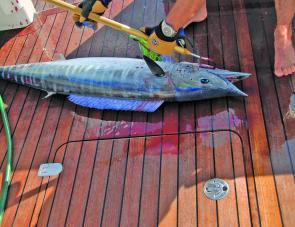
Make sure you have plenty of clear deck space before hoisting a wahoo aboard.

Wahoo can do some serious damage to your billfish lures.
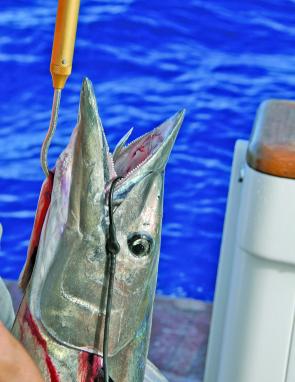
These teeth can sever a tuna in half with one strike so keep your fingers clear.
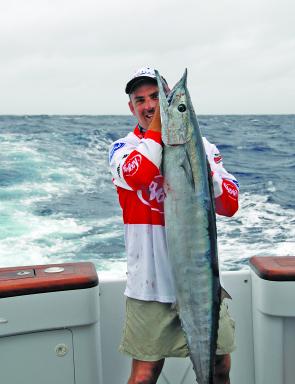
Big wahoo are a great sportfish and are fantastic tucker too.
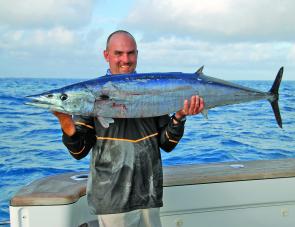
Trophy fish will bring a smile to any angler’s dial – including mine.
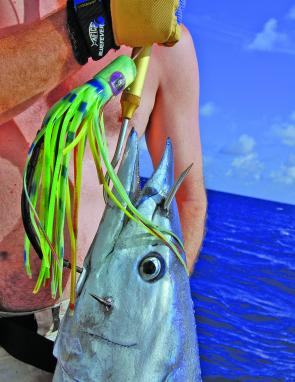
With an aggressive strike, it’s not uncommon to have wahoo hooked outside the mouth.

